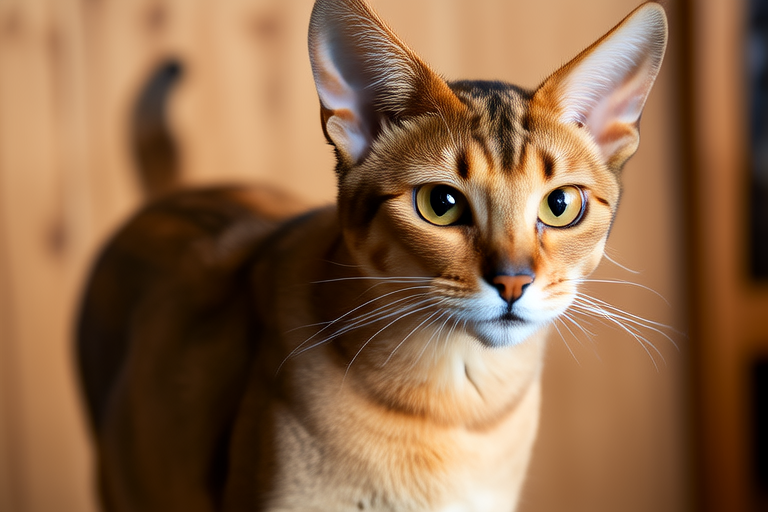Abyssinian Cats: Unraveling the Mystery Behind Their Exotic Looks
The world of feline companions is vast and varied, but few breeds capture the imagination quite like the Abyssinian cat. With their striking appearance and enigmatic background, these cats have long been a subject of fascination for cat lovers and historians alike. In this article, we will delve into the unique features of the Abyssinian cat, explore the theories behind their origins, and provide valuable insights into their care and temperament.
Distinctive Appearance: A Closer Look at the Coat
The first thing that strikes you about an Abyssinian cat is its coat. This breed boasts a distinctive ticked or agouti coat pattern, where each hair has bands of color. The base color is typically a warm shade of cinnamon, known as ruddy, but other recognized colors include blue, fawn, and sorrel. These colors are interspersed with darker bands, giving the coat a shimmering, almost metallic appearance. This unique coat texture, combined with large, expressive ears and almond-shaped eyes, makes the Abyssinian stand out among other cat breeds.
But what sets the Abyssinian apart is not just its appearance; it’s also the way it moves. These cats are graceful and agile, often displaying a regal demeanor that seems to match their exotic looks. Their bodies are slender yet muscular, and their tails are long and tapering, adding to their overall elegance.
Ancient Origins: Tracing the Roots of the Abyssinian
The origins of the Abyssinian cat are steeped in mystery and legend. One popular theory suggests that these cats may have descended from ancient Egyptian temple cats, given their resemblance to the statues and paintings found in Egyptian tombs. However, genetic studies have revealed that the Abyssinian is more closely related to cats from Southeast Asia and India, particularly those found around the Indian Ocean.
The breed’s name, Abyssinian, comes from the former country of Abyssinia, now known as Ethiopia. It is believed that the first Abyssinians were brought to Britain after the Abyssinian War (now known as the First Anglo-Egyptian War) in the mid-19th century. These early cats were likely descendants of wild African cats, which had been selectively bred over generations for their striking appearance.
Despite these theories, the exact origins of the Abyssinian remain a topic of debate among historians and cat enthusiasts. What is certain, however, is that these cats have been cherished as companions for centuries, and their enduring popularity speaks to their unique charm and personality.
Temperament: Intelligent and Playful Companions
Beyond their striking appearance, Abyssinian cats are known for their engaging personalities. They are often described as intelligent, curious, and highly active. These cats thrive on mental stimulation and enjoy interactive toys and puzzles that challenge their problem-solving skills. Their playful nature means they are always ready for a game of fetch or a session of hide-and-seek around the house.
One of the most appealing aspects of owning an Abyssinian is their strong bond with their human companions. These cats are affectionate and enjoy spending time with their owners, often following them from room to room. However, they are also independent creatures, capable of entertaining themselves when necessary. This balance between affection and independence makes them ideal companions for busy households.
Another characteristic that sets the Abyssinian apart is their vocal nature. While not as talkative as some other breeds, such as the Siamese, they are known to be communicative and will often chirp or chatter when they want attention or have something to say. Their voices are soft and melodious, adding to their overall charm.
Care Requirements: Ensuring a Healthy and Happy Abyssinian
To keep your Abyssinian healthy and happy, it’s important to meet their specific care needs. Proper nutrition is essential for maintaining their sleek coats and energetic lifestyles. Abyssinians generally do well on high-quality commercial cat food, but it’s always best to consult with your veterinarian to determine the best diet for your individual cat.
Grooming is another important aspect of caring for an Abyssinian. While their short coats require minimal brushing, regular grooming sessions can help remove loose hairs and distribute natural oils throughout the coat. Bathing should be done only when necessary, as frequent bathing can strip the coat of its natural oils. Regular nail trimming and dental care are also crucial for maintaining good health.
Exercise is vital for keeping your Abyssinian fit and engaged. Providing plenty of climbing structures, scratching posts, and interactive toys can help satisfy their need for physical activity. Regular playtime not only keeps them physically healthy but also strengthens the bond between you and your cat.
Interesting Facts and Myths
There are many fascinating facts and myths surrounding the Abyssinian cat. One common myth is that these cats are direct descendants of ancient Egyptian temple cats. While the breed does share similarities with Egyptian depictions of cats, modern genetic studies suggest that their origins are more complex and diverse.
Another intriguing fact is that the Abyssinian is one of the oldest known domestic cat breeds. Its close relation to wild cats from Southeast Asia and India indicates that it has been a companion to humans for thousands of years. This ancient lineage has contributed to the breed’s resilience and adaptability, making it a popular choice for both pet owners and breeders.
In conclusion, the Abyssinian cat is a truly unique and captivating breed. From their striking coat patterns to their intelligent and playful personalities, these cats offer much to admire and cherish. Whether you’re a seasoned cat lover or considering adopting your first feline companion, the Abyssinian is sure to leave a lasting impression. By understanding their origins, temperament, and care needs, you can ensure a fulfilling and joyful relationship with one of these remarkable creatures.
